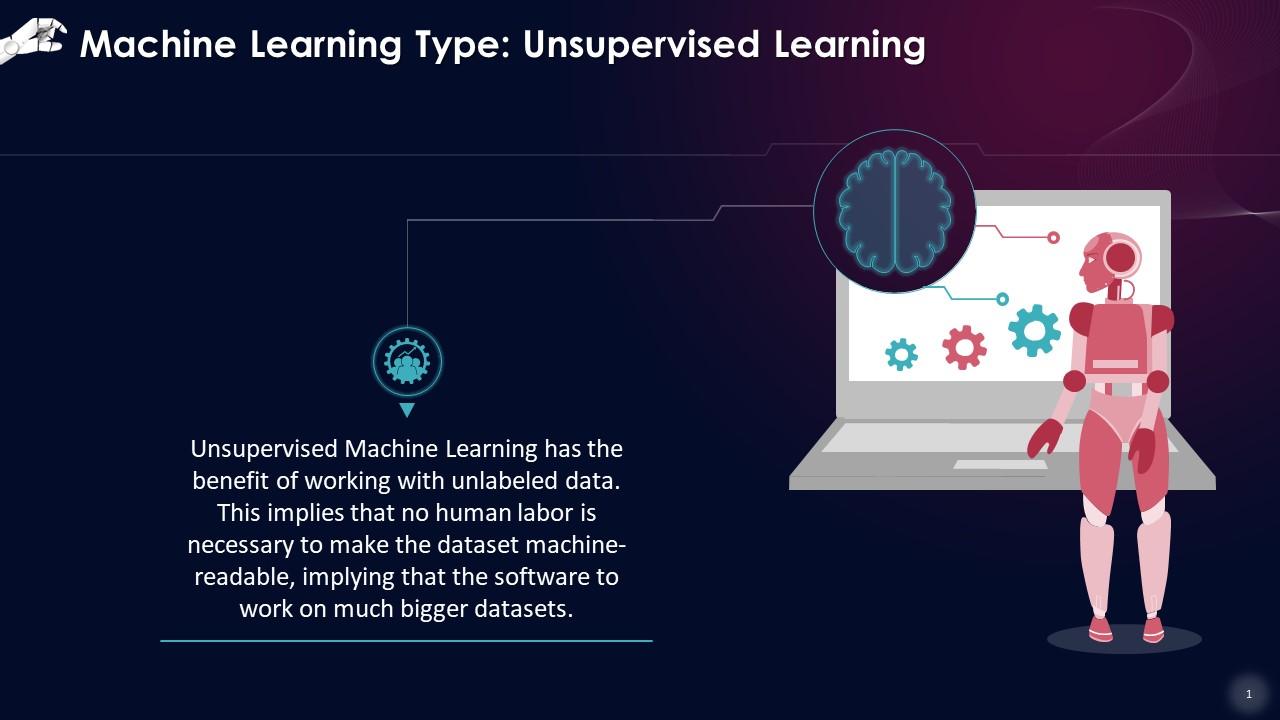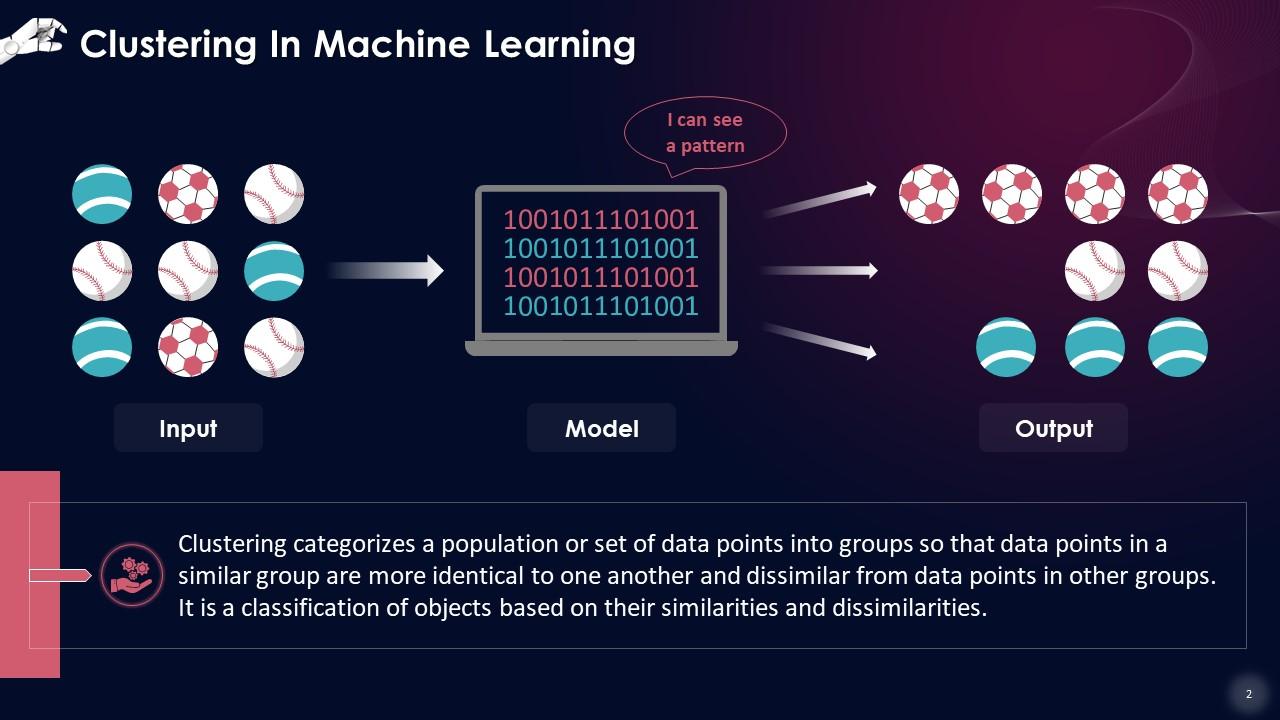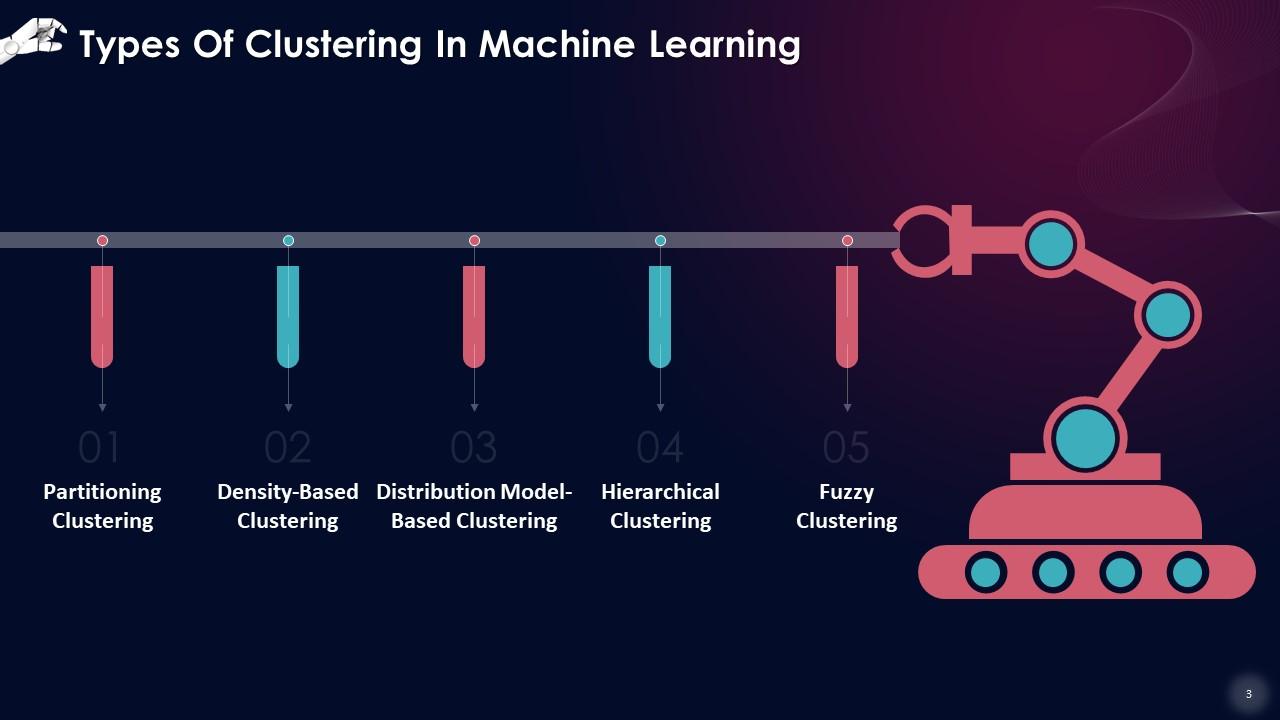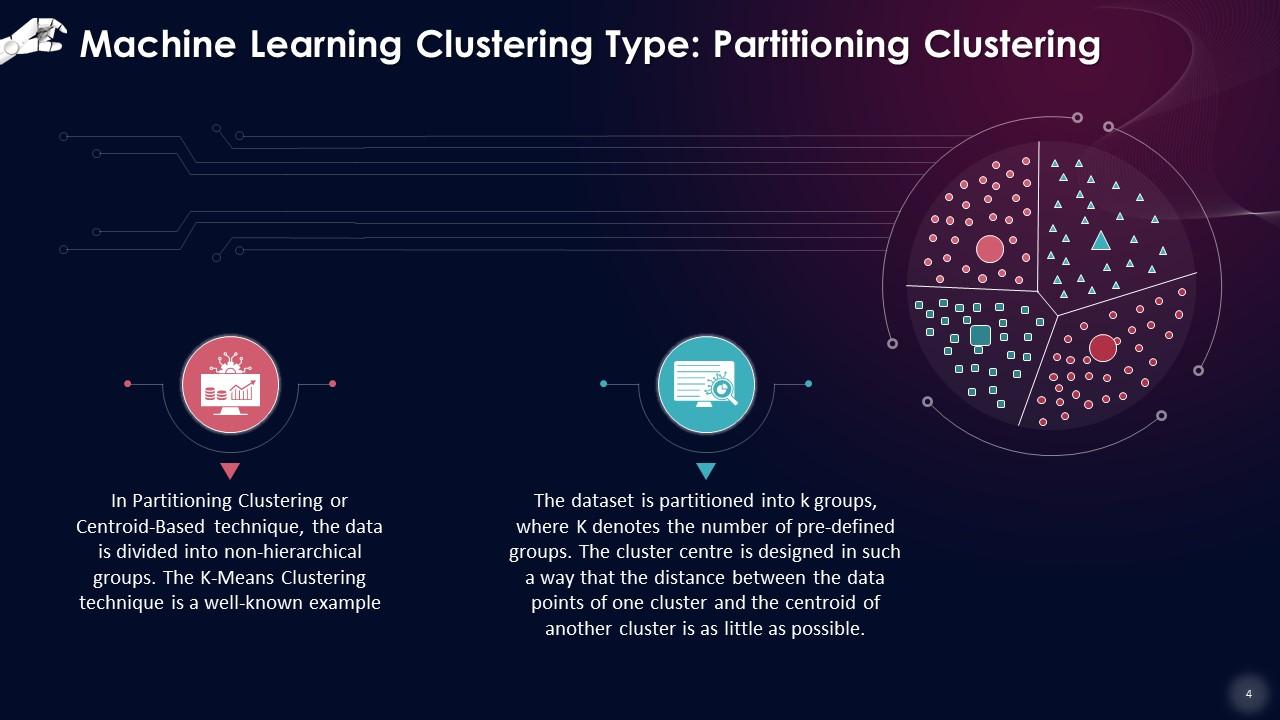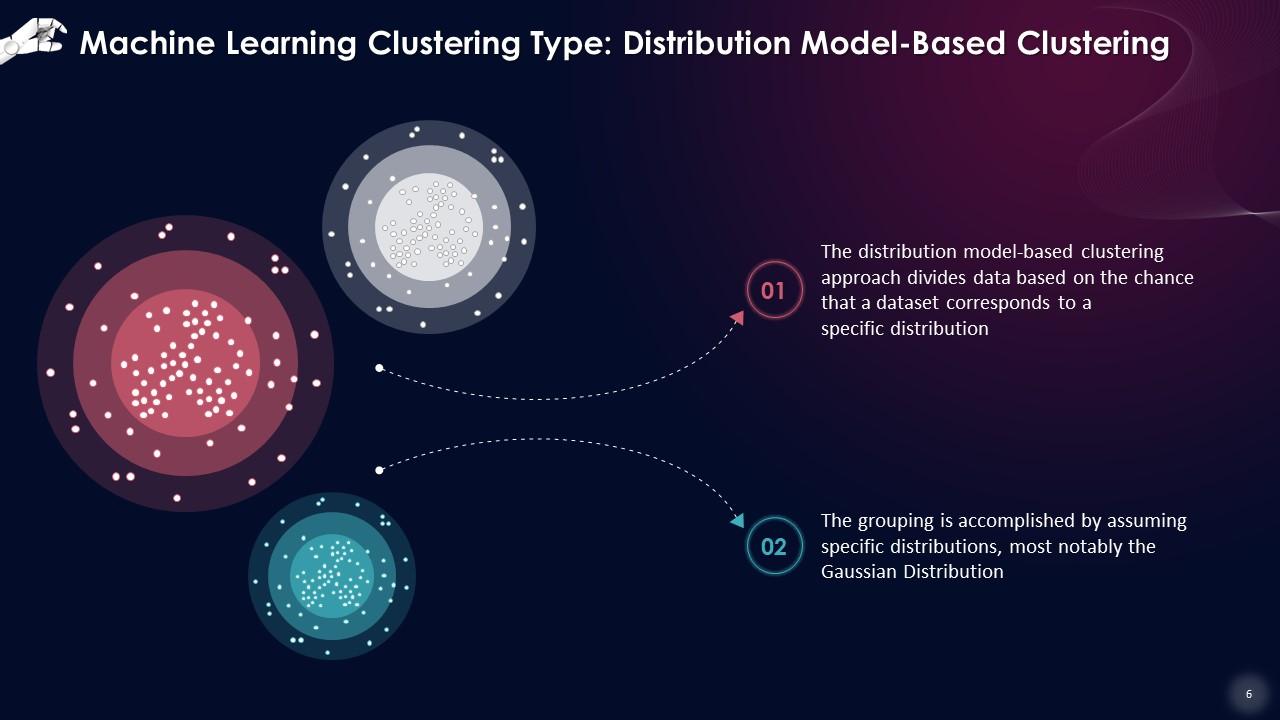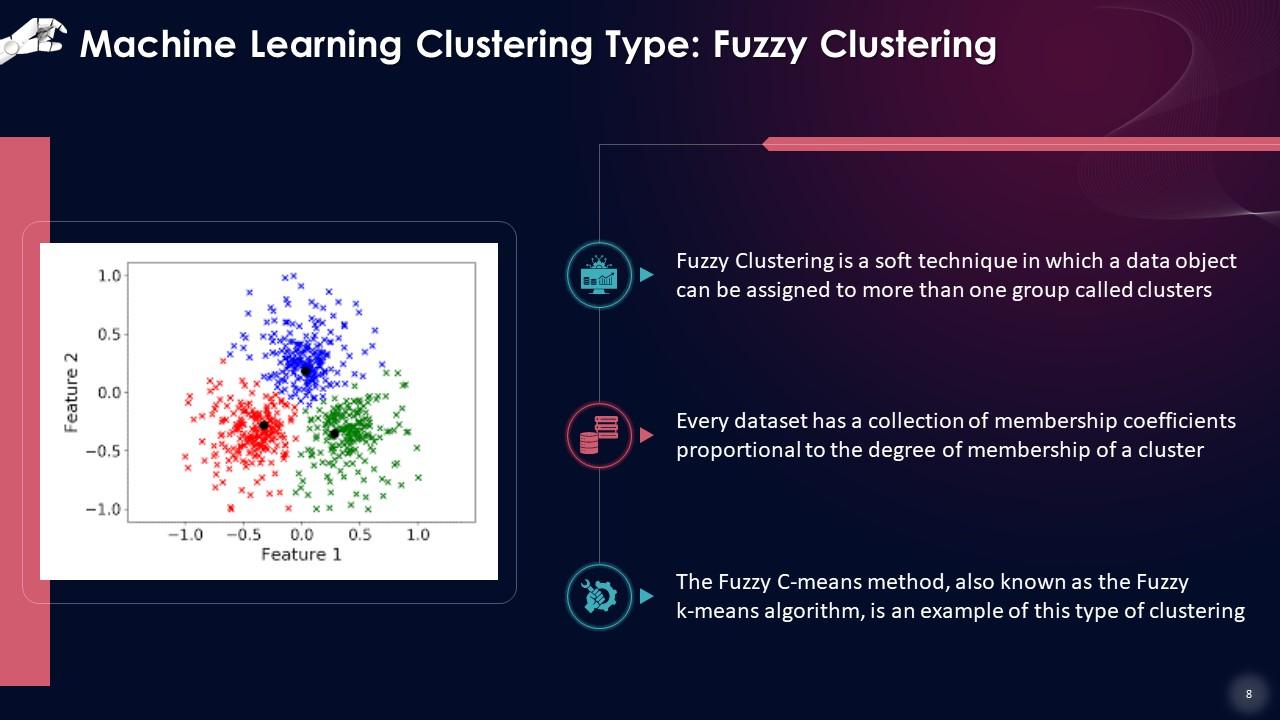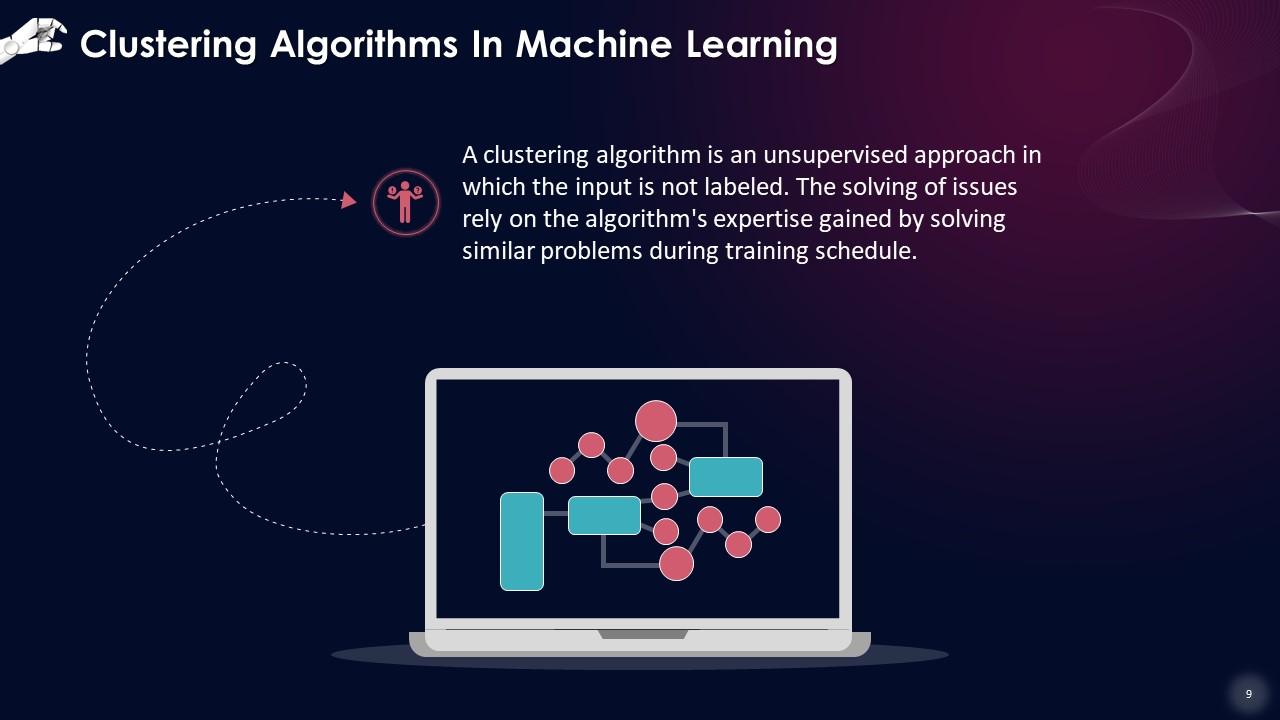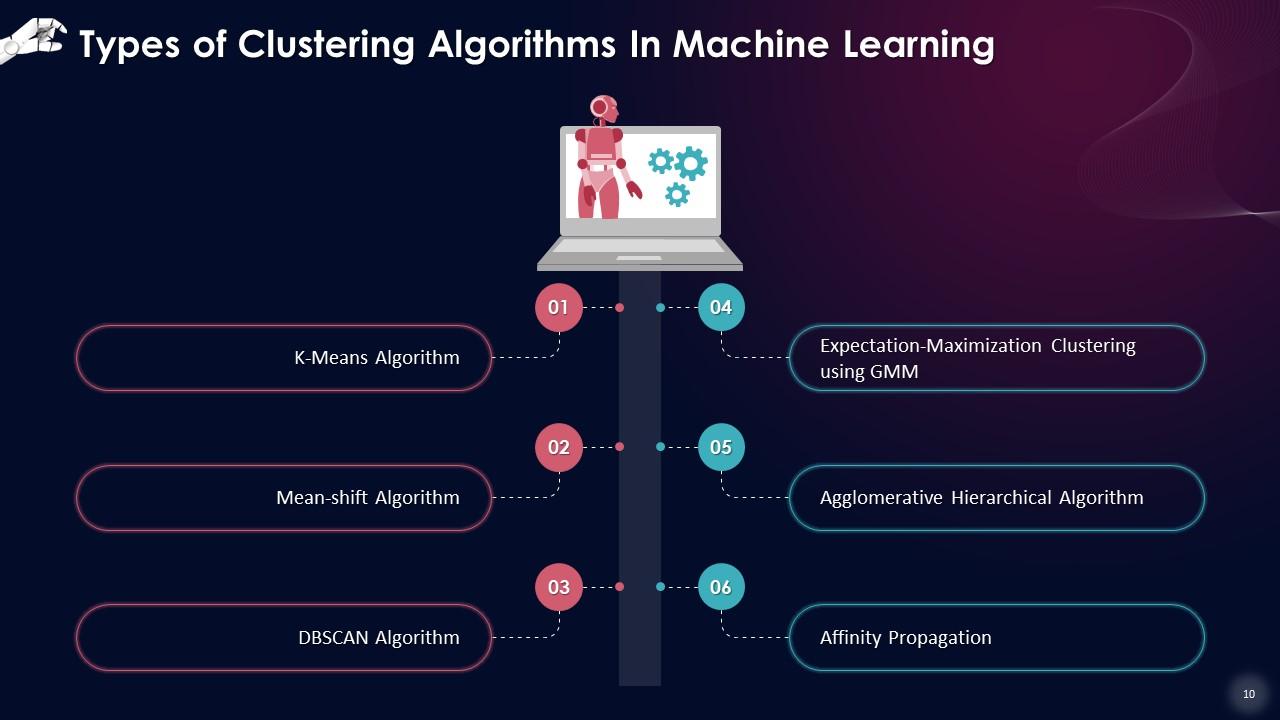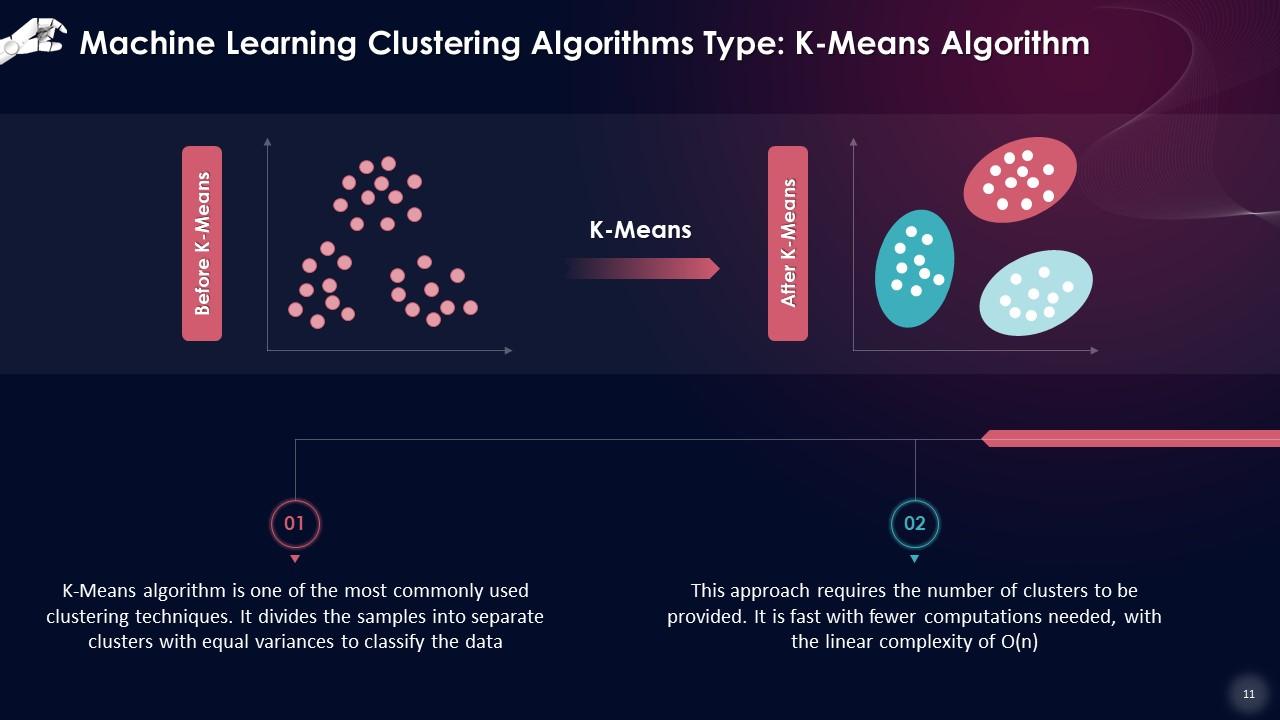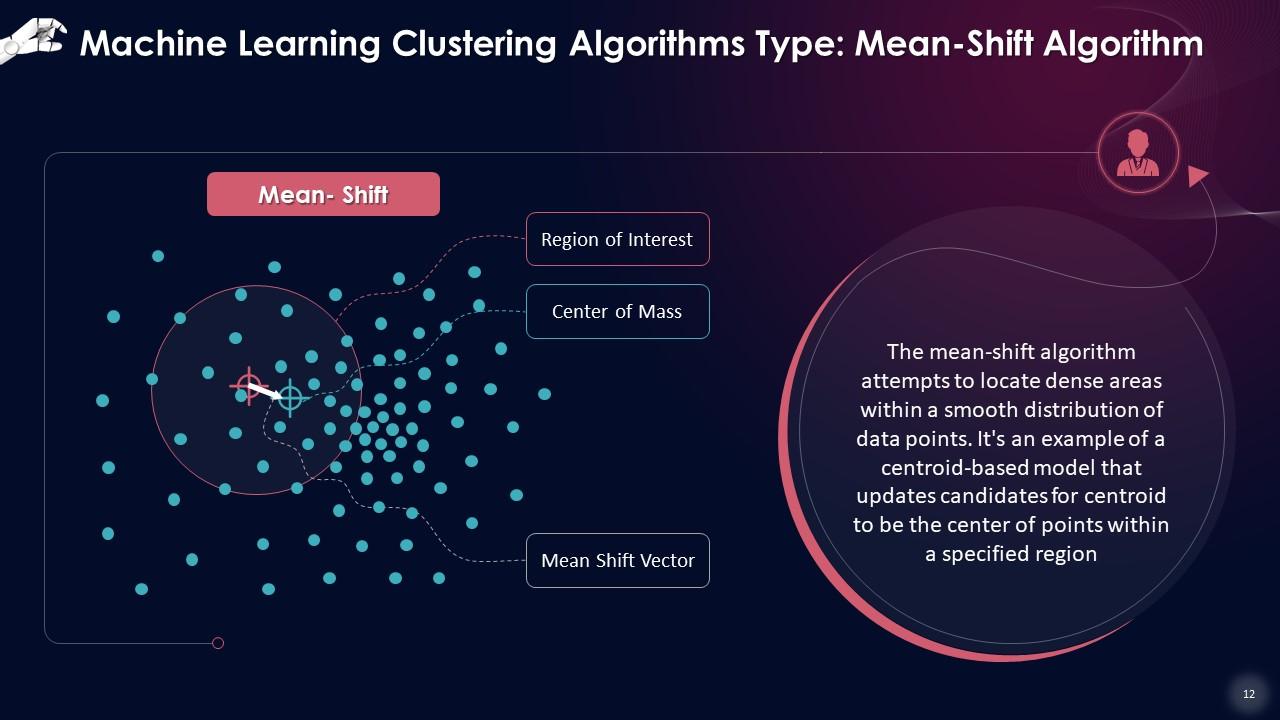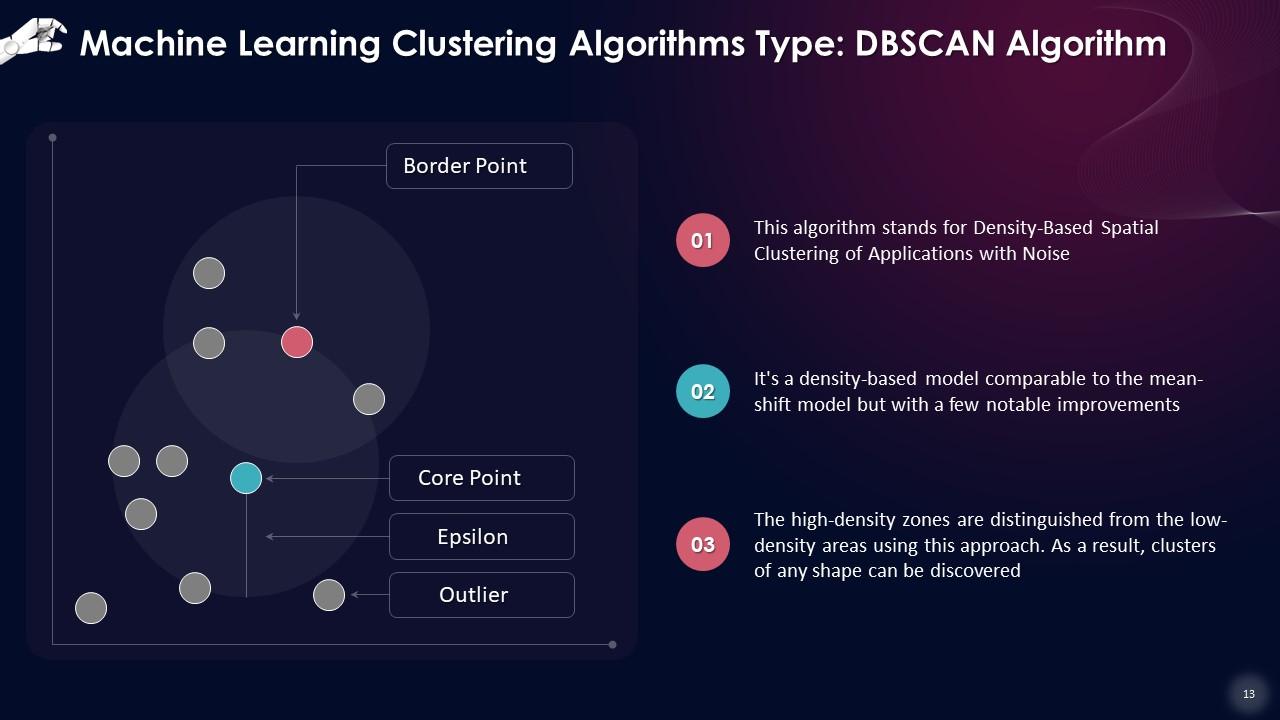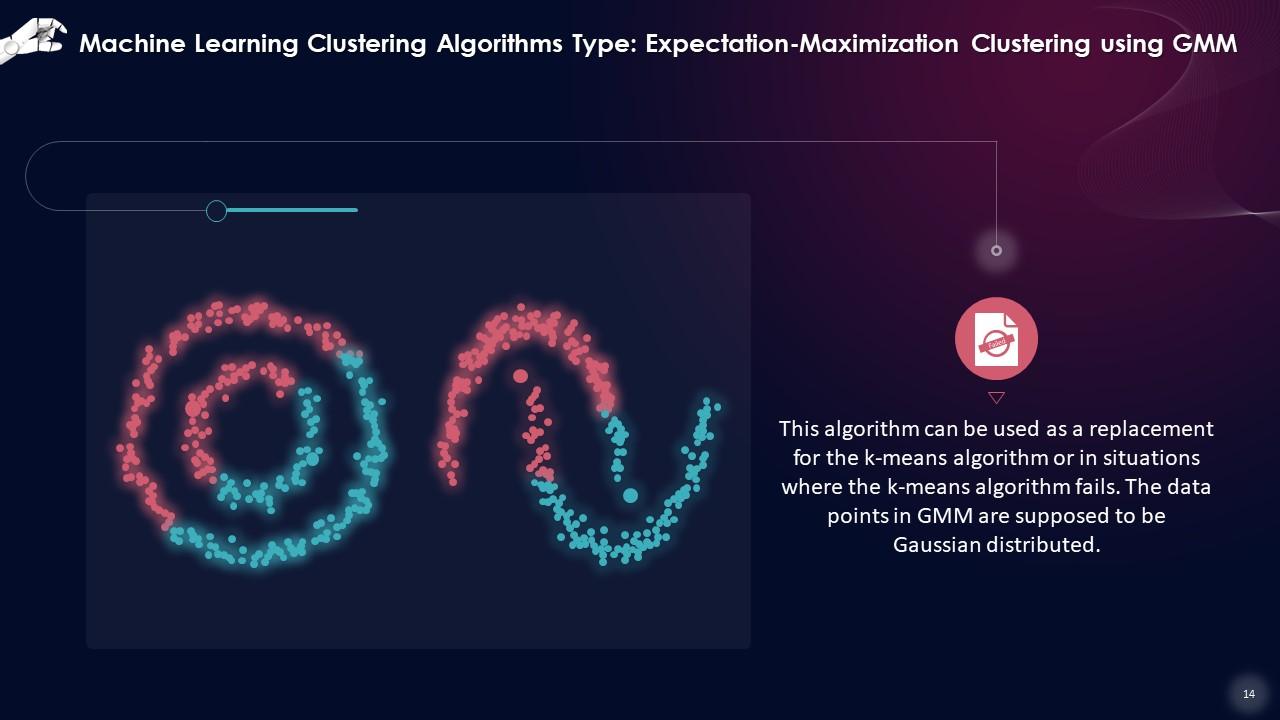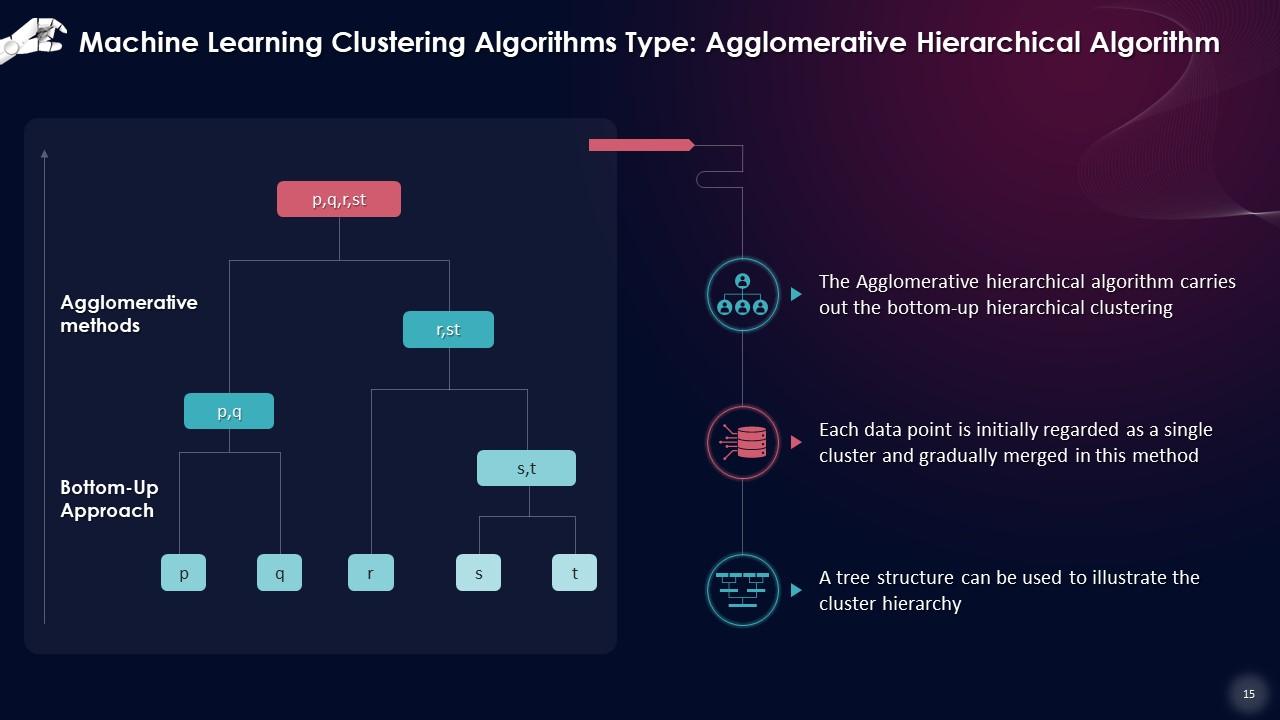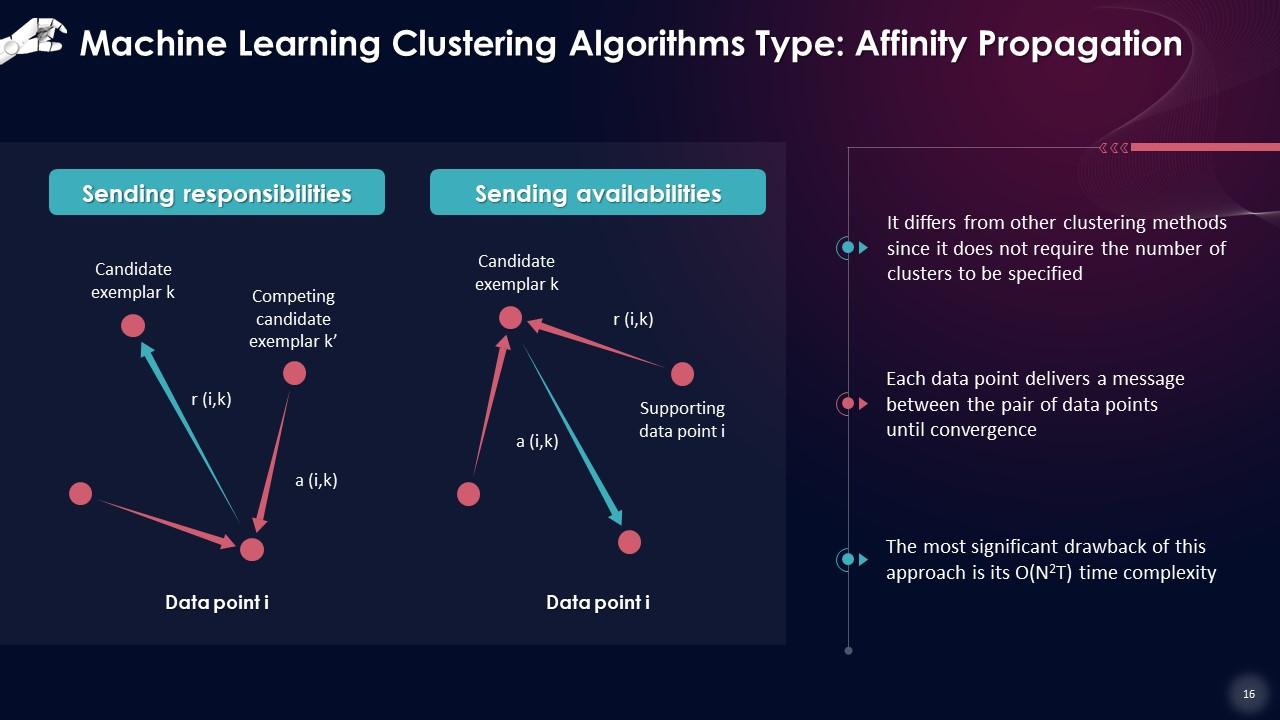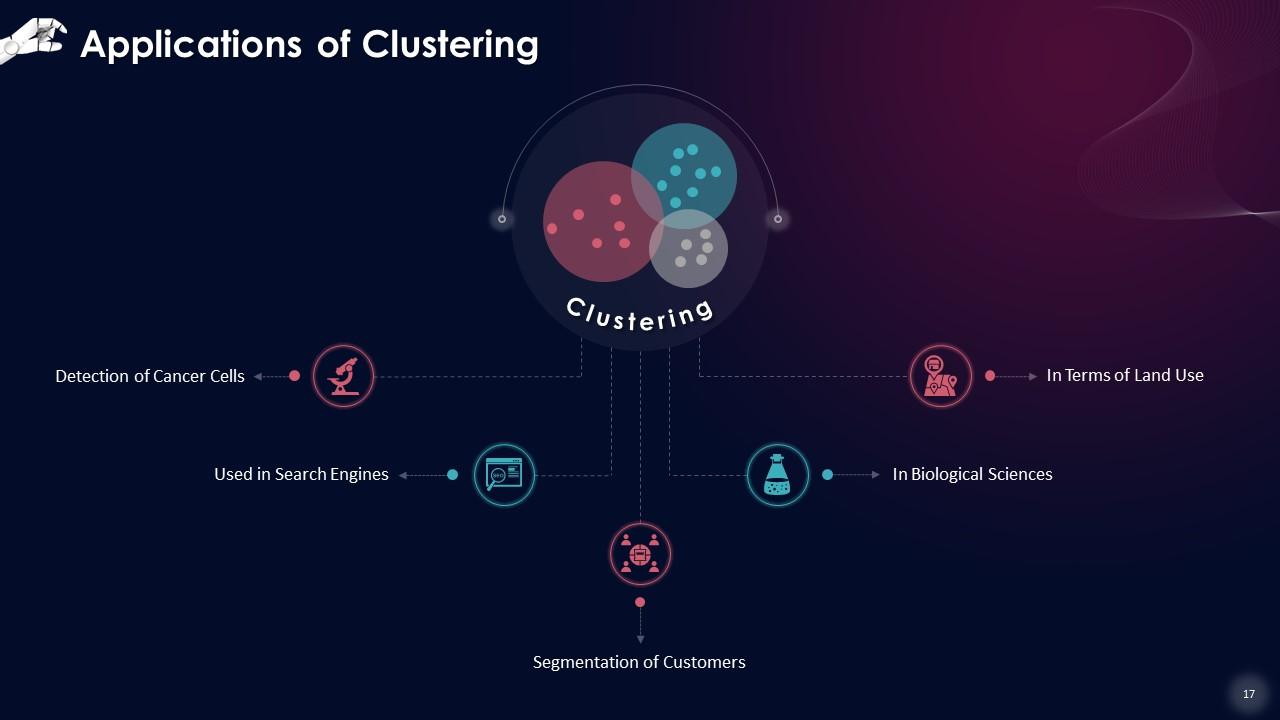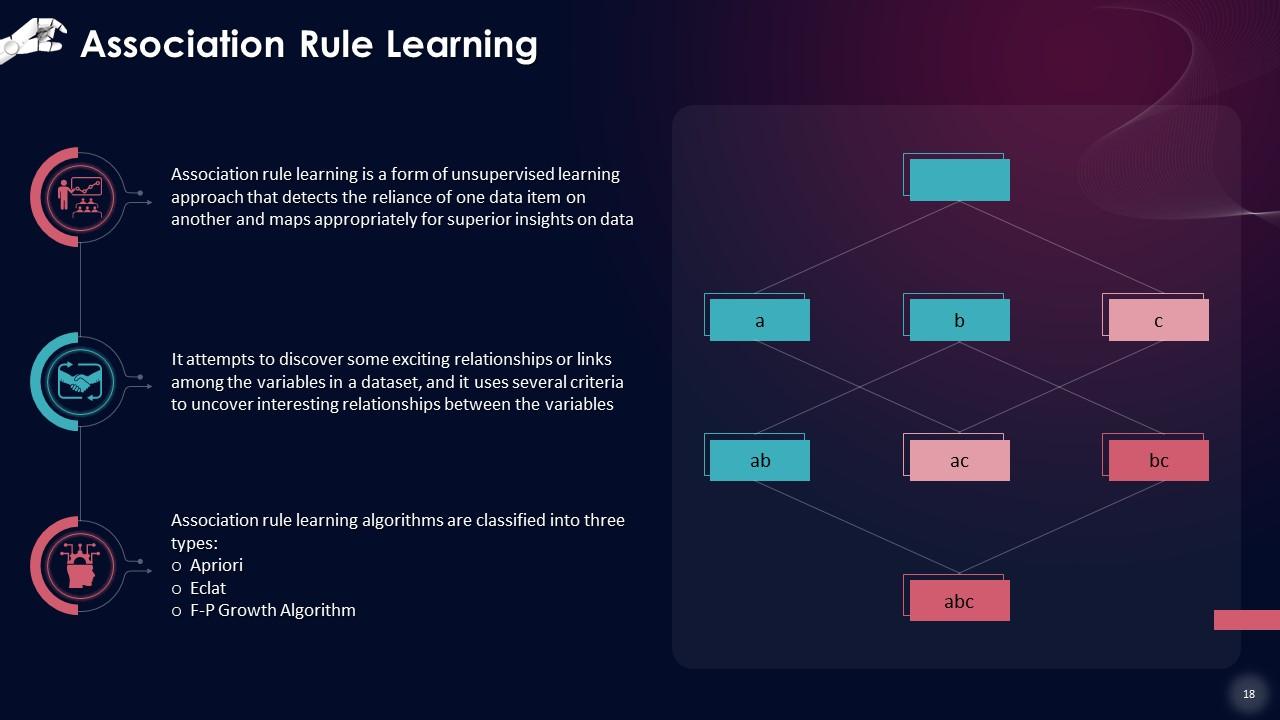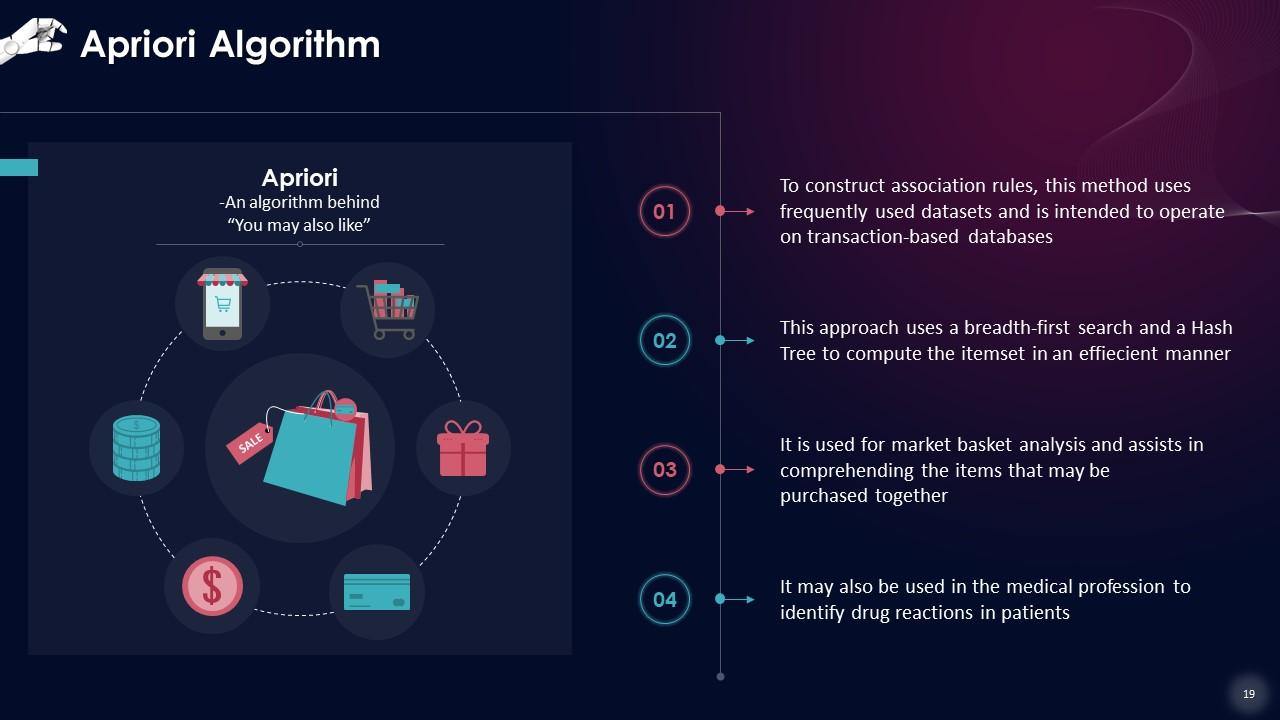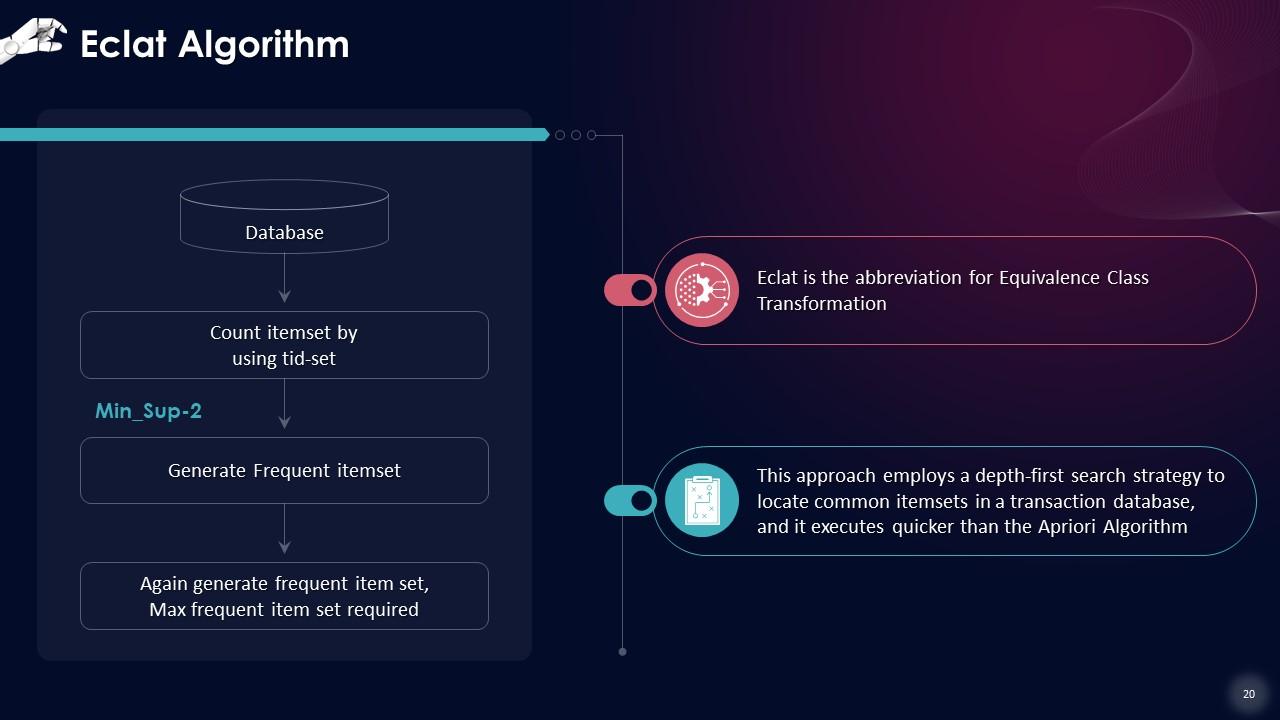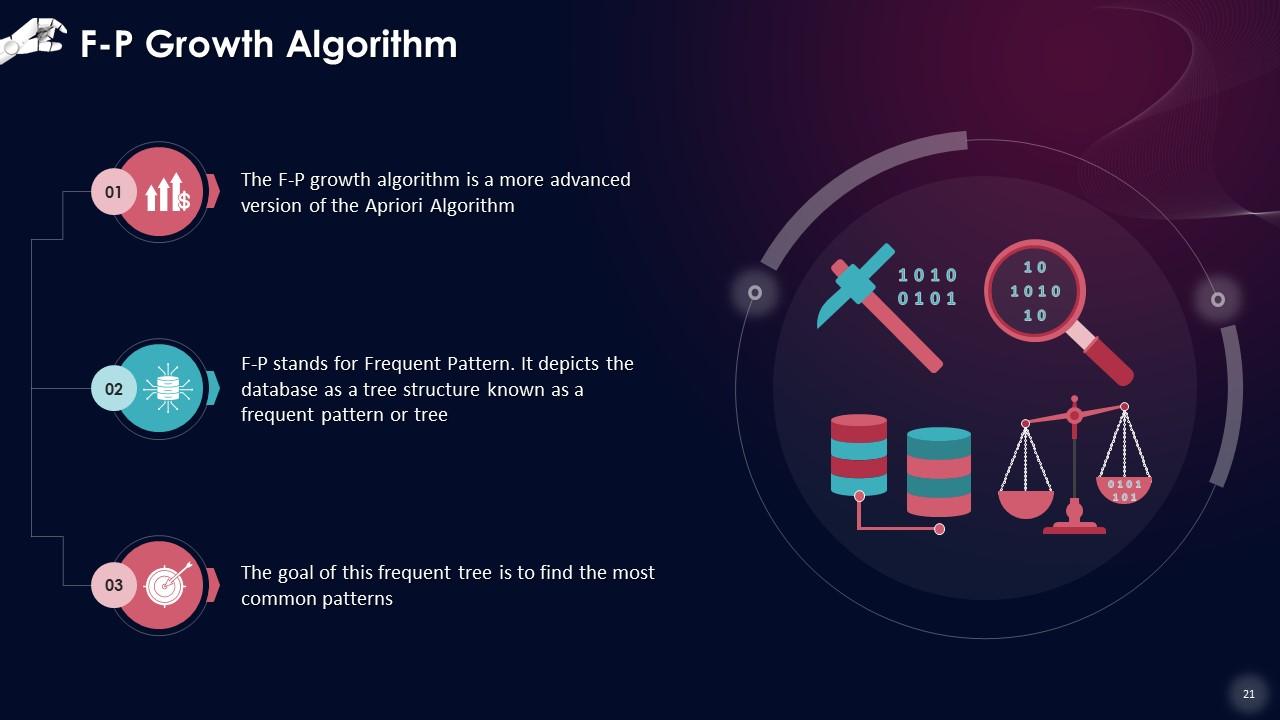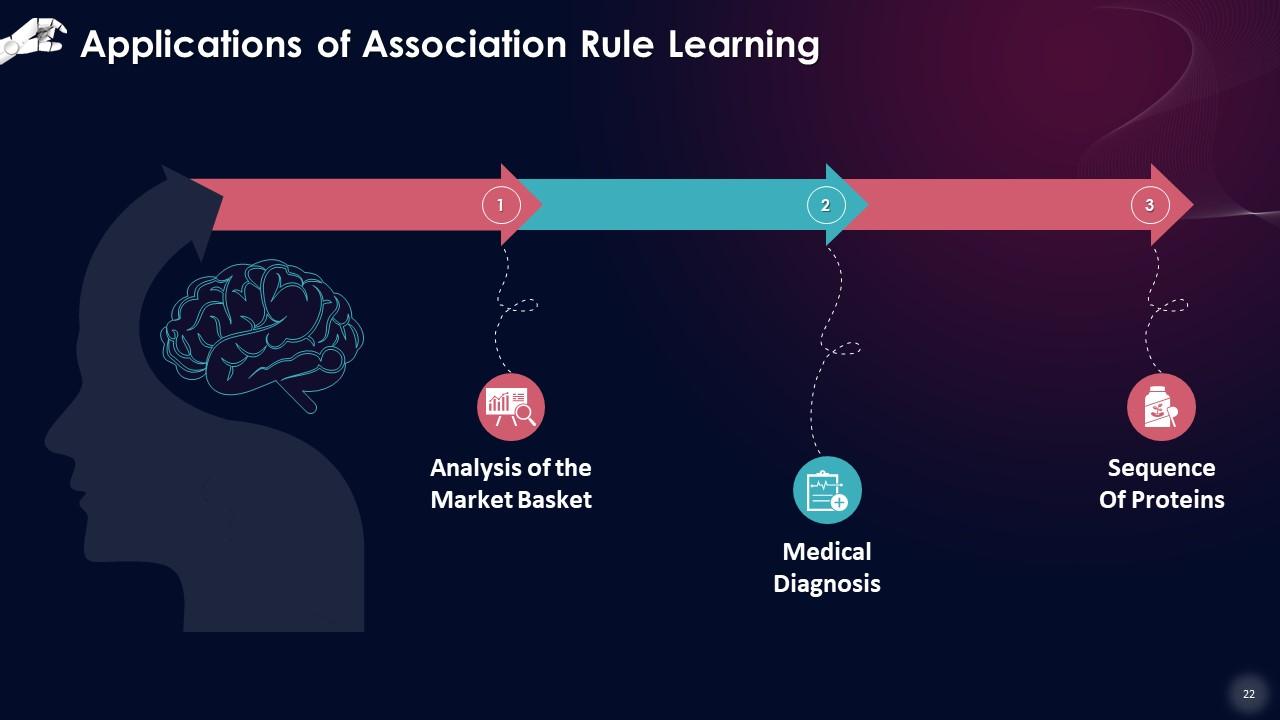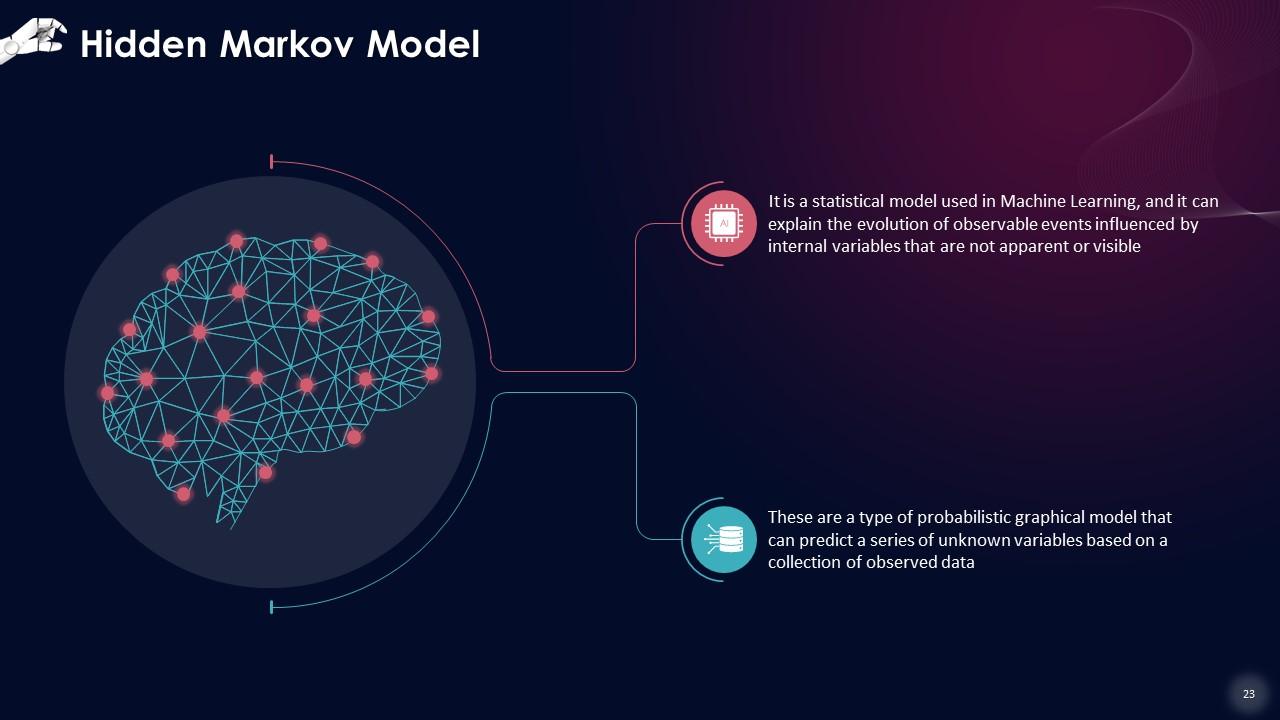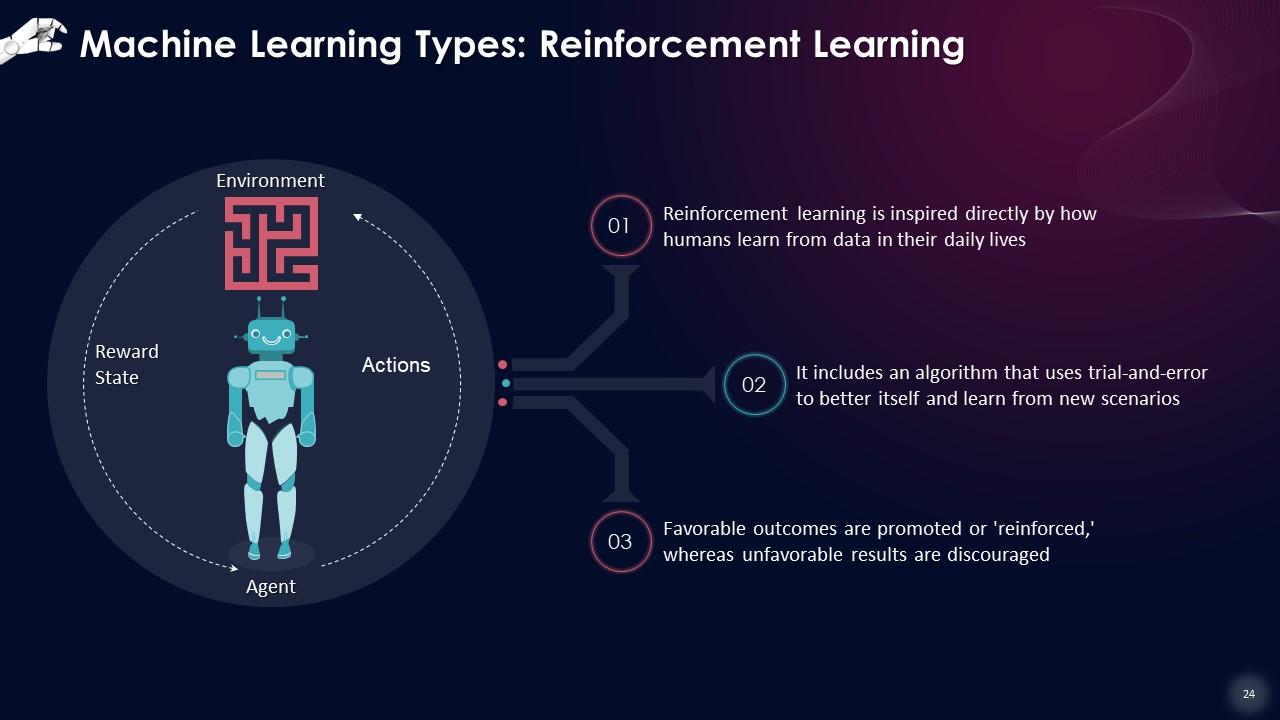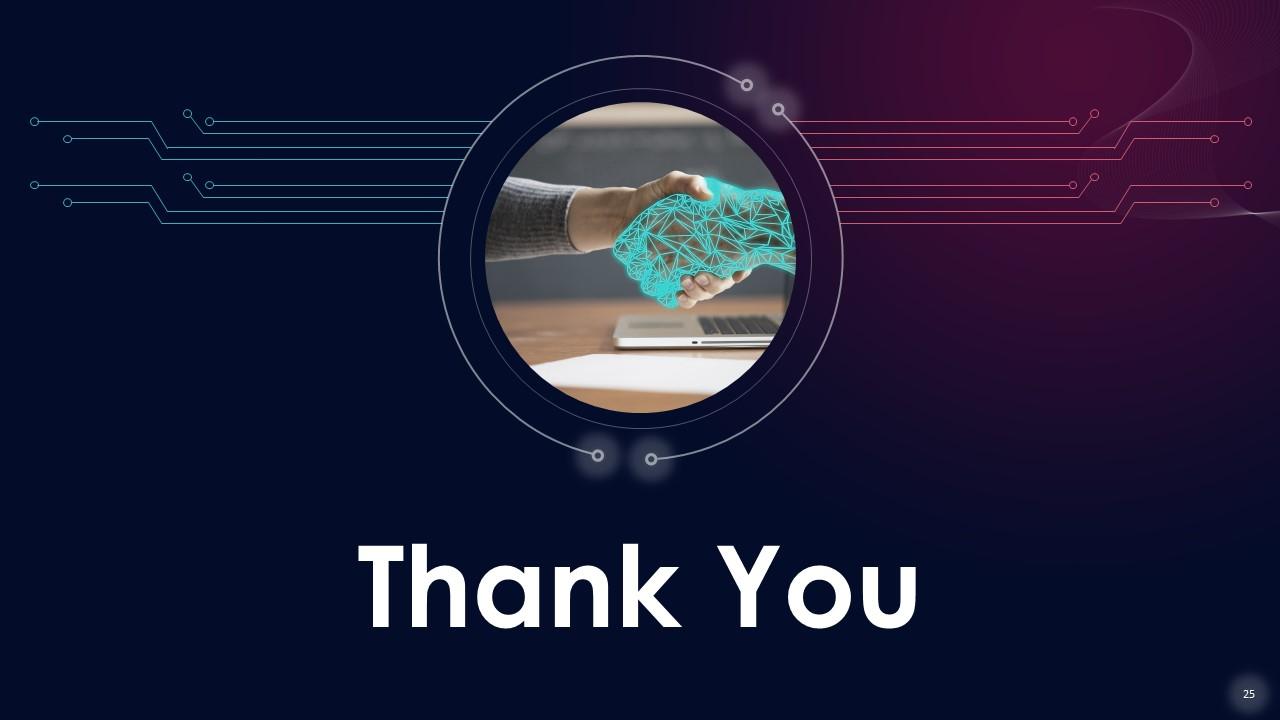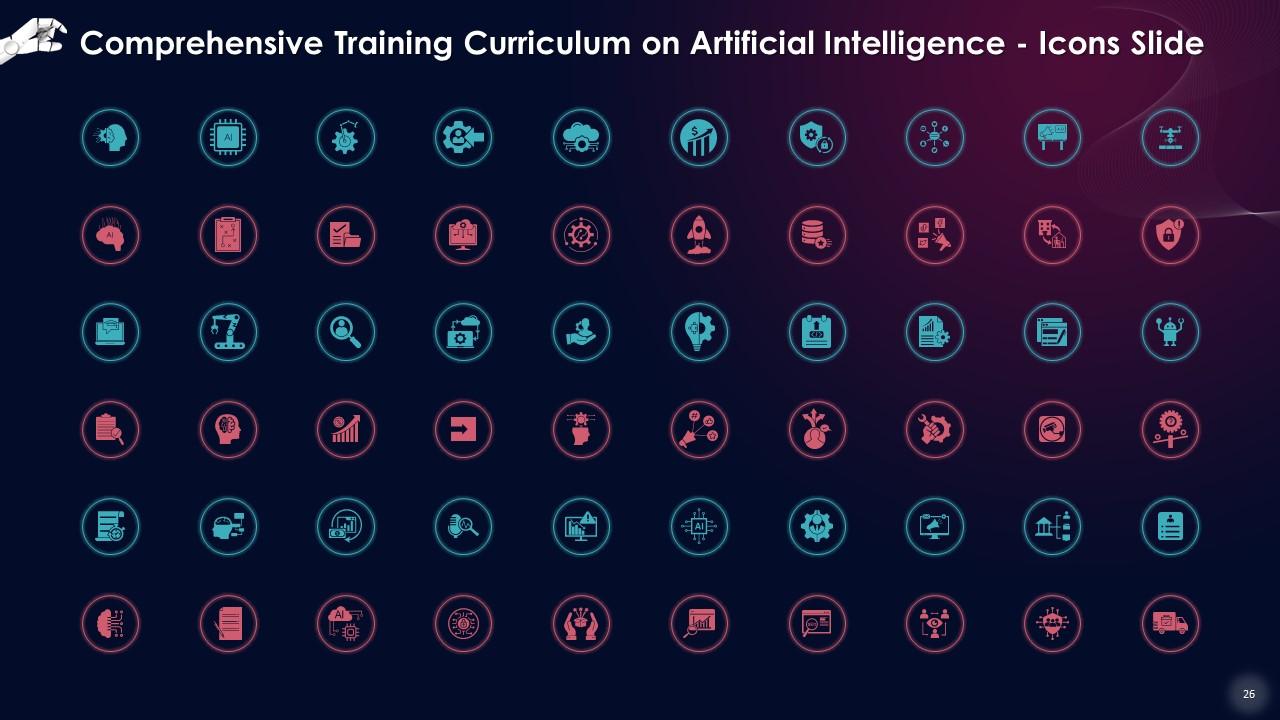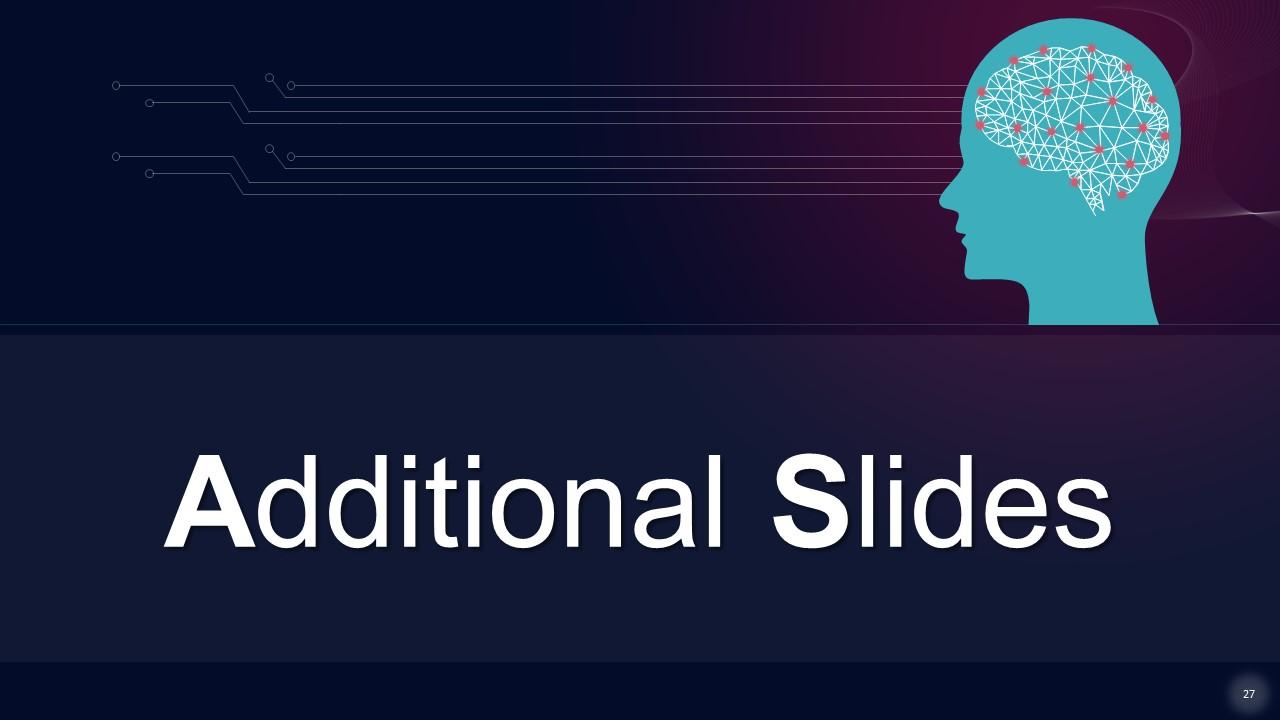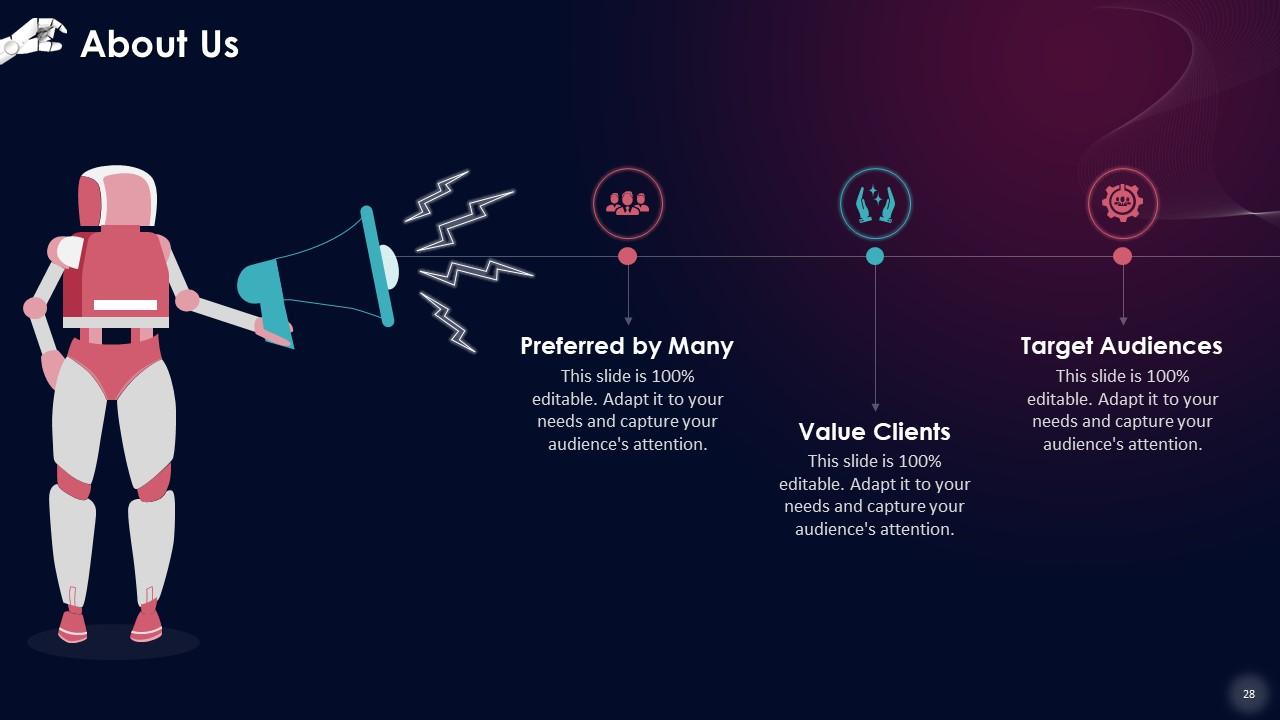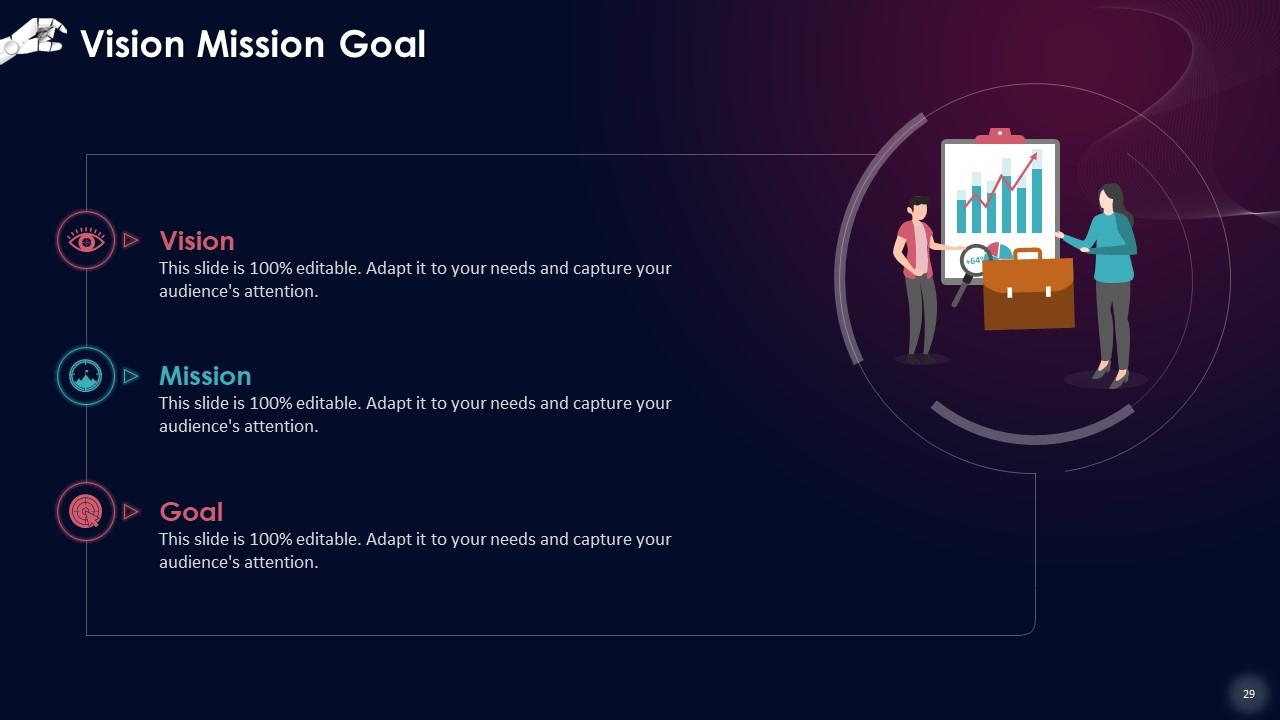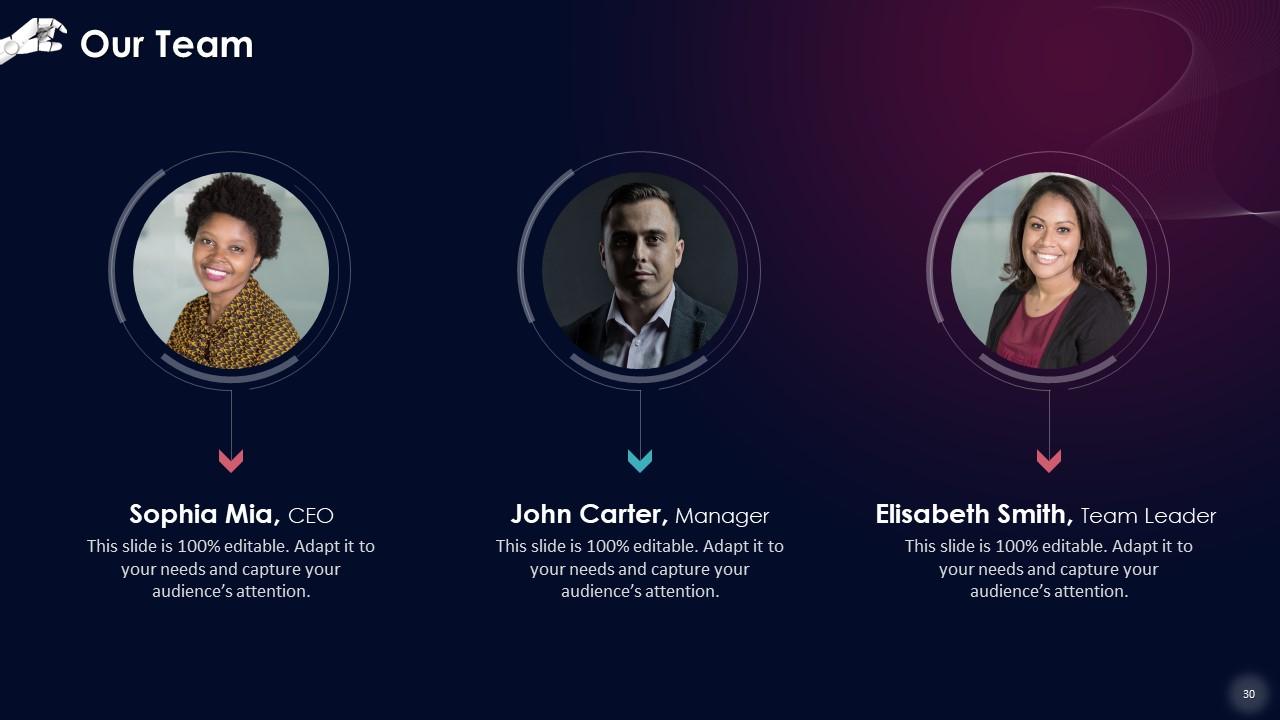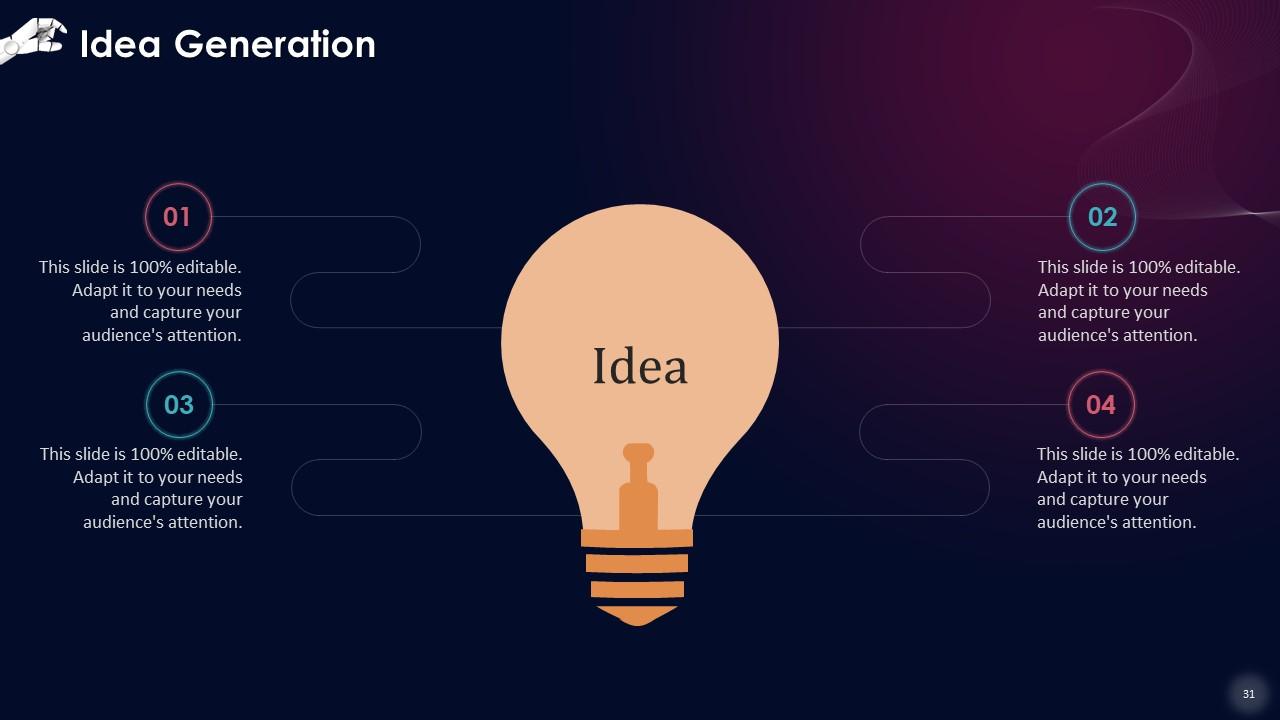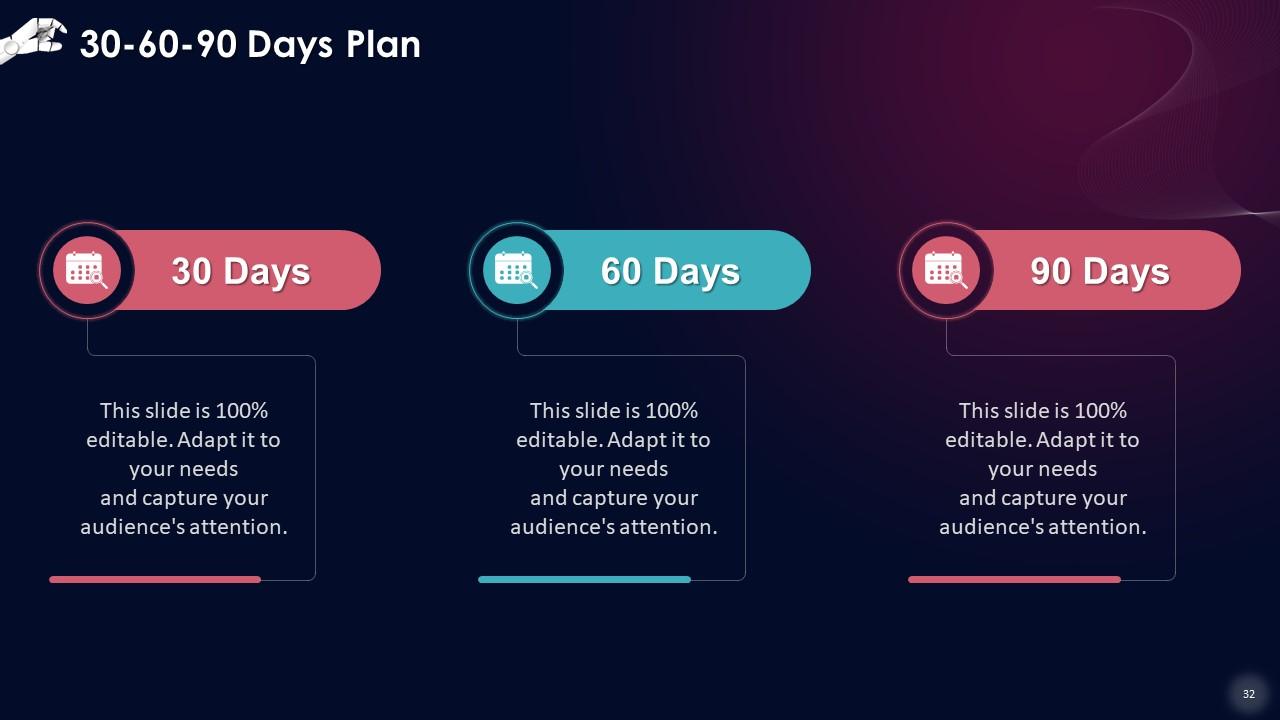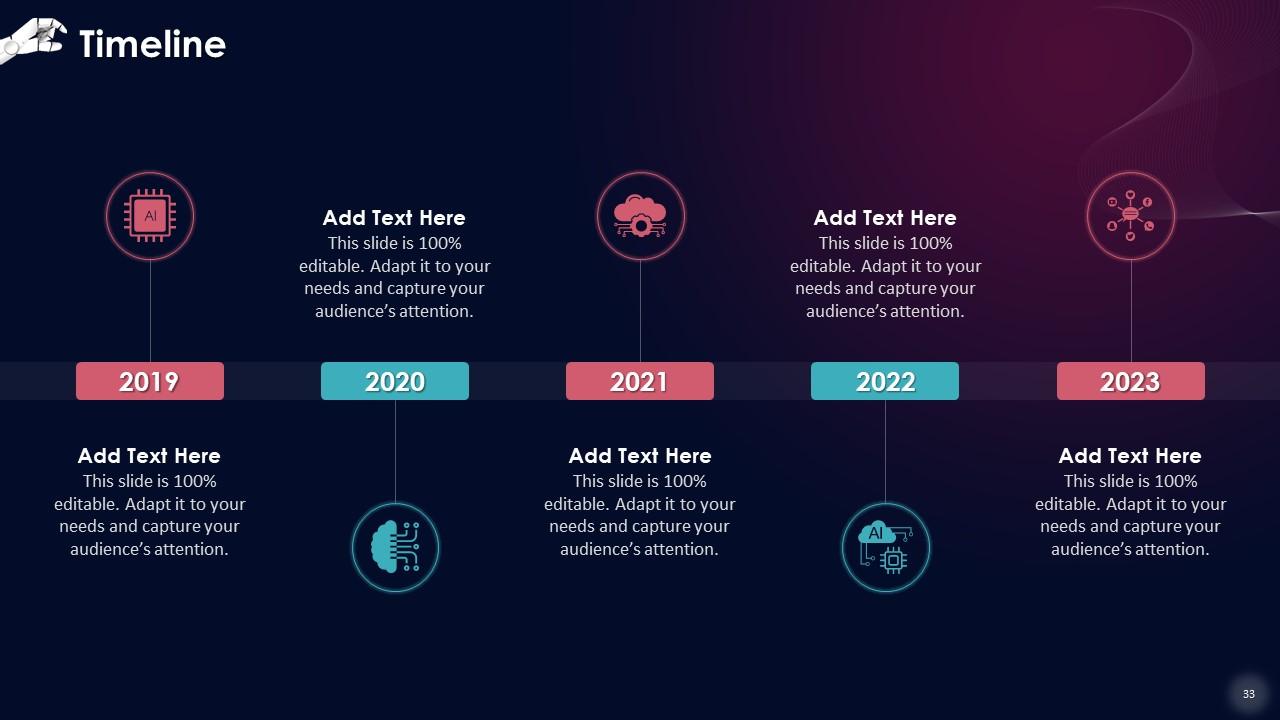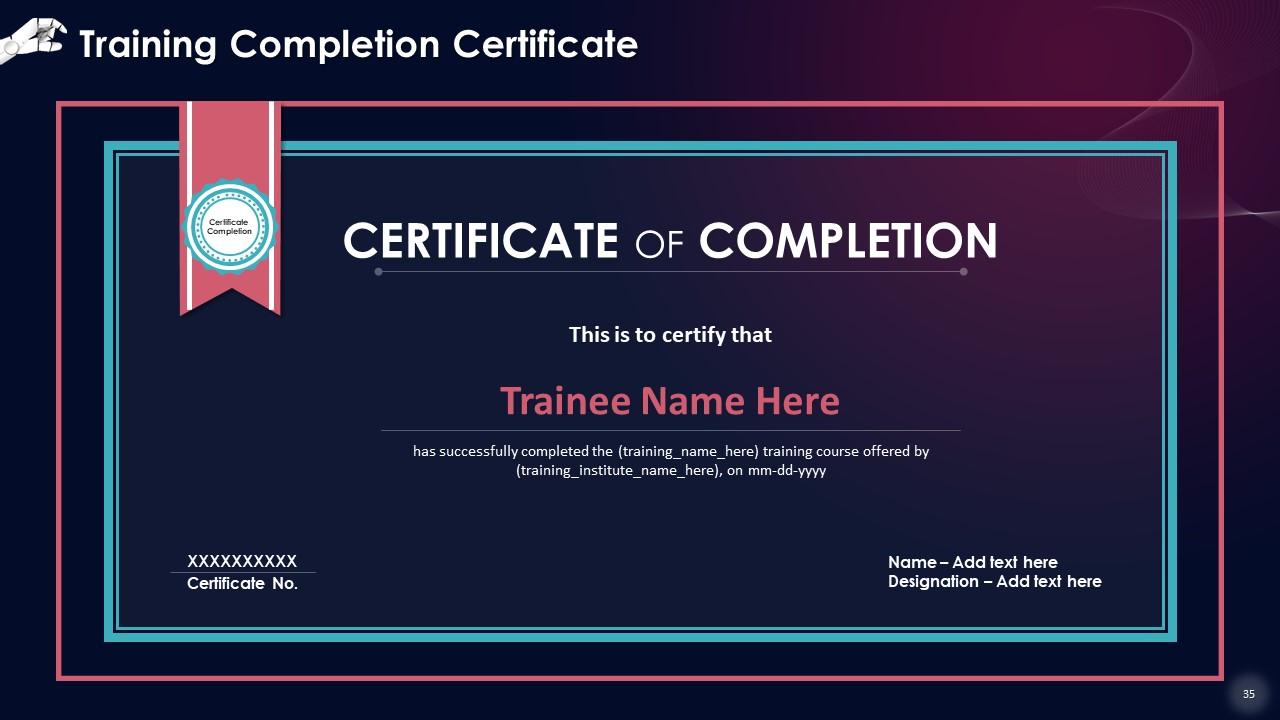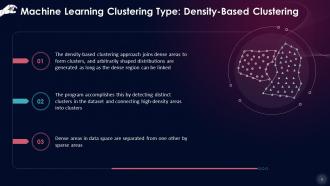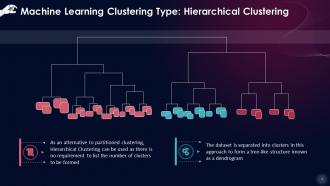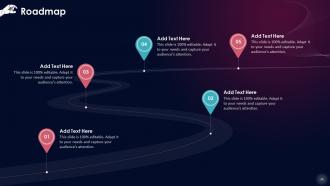Core Concepts Of Unsupervised Machine Learning Training Ppt
These slides provide an introduction to unsupervised Machine Learning. Various clustering methods, such as Partitioning Clustering, Density-Based Clustering, Distribution Model-Based Clustering, Hierarchical Clustering, and Fuzzy Clustering, are discussed. They also talk about clustering algorithms such as K-Means, mean-shift, DBSCAN, expectation-maximization clustering using GMM, agglomerative hierarchical algorithm, and affinity propagation. Clustering can be used in the detection of cancer cells, search engines, segmentation of customers, biological sciences, and land use.
These slides provide an introduction to unsupervised Machine Learning. Various clustering methods, such as Partitioning Clu..
- Google Slides is a new FREE Presentation software from Google.
- All our content is 100% compatible with Google Slides.
- Just download our designs, and upload them to Google Slides and they will work automatically.
- Amaze your audience with SlideTeam and Google Slides.
-
Want Changes to This PPT Slide? Check out our Presentation Design Services
- WideScreen Aspect ratio is becoming a very popular format. When you download this product, the downloaded ZIP will contain this product in both standard and widescreen format.
-

- Some older products that we have may only be in standard format, but they can easily be converted to widescreen.
- To do this, please open the SlideTeam product in Powerpoint, and go to
- Design ( On the top bar) -> Page Setup -> and select "On-screen Show (16:9)” in the drop down for "Slides Sized for".
- The slide or theme will change to widescreen, and all graphics will adjust automatically. You can similarly convert our content to any other desired screen aspect ratio.
Compatible With Google Slides

Get This In WideScreen
You must be logged in to download this presentation.
PowerPoint presentation slides
Presenting Core Concepts of Unsupervised Machine Learning. These slides are 100 percent made in PowerPoint and are compatible with all screen types and monitors. They also support Google Slides. Premium Customer Support available. Suitable for use by managers, employees, and organizations. These slides are easily customizable. You can edit the color, text, icon, and font size to suit your requirements.
People who downloaded this PowerPoint presentation also viewed the following :
Content of this Powerpoint Presentation
Slide 1
This slide showcases that Unsupervised Machine Learning has the benefit of working with unlabeled data. This implies that no human labor is necessary to make the dataset machine-readable, implying that the software to work on much bigger datasets.
Slide 2
This slide introduces clustering in Machine Learning which categorizes a population or sets data points into clusters so that data points in a similar group are more identical to one another and dissimilar from data points in other groups. It is a classification of objects based on their similarities and dissimilarities.
Slide 3
This slide lists that there are a variety of Clustering techniques available. The following are the most common clustering approaches used in Machine Learning: Partitioning Clustering, Density-Based Clustering, Distribution Model-Based Clustering, Hierarchical Clustering and Fuzzy Clustering.
Slide 4
This slide illustrates that the data is divided into non-hierarchical groups in Partitioning Clustering or Centroid-Based technique. The K-Means Clustering technique is a well-known example. The dataset is partitioned into K groups, where K denotes the number of pre-defined groups. The cluster center is designed in such a way that the distance between the data points of one cluster and the centroid of another cluster is as little as possible.
Slide 5
This slide states that the density-based clustering approach joins dense areas to form clusters, and arbitrarily shaped distributions are generated as long as the dense region can be linked. The program accomplishes this by detecting distinct clusters in the dataset and connecting high-density areas into clusters.
Instructor Notes: If the dataset has high density and multiple dimensions, these algorithms may struggle to cluster the data points.
Slide 6
This slide explains that the distribution model-based clustering approach divides data based on the chance that a dataset corresponds to a specific distribution. The grouping is accomplished by assuming specific distributions, most notably the Gaussian Distribution.
Instructor Notes: The Expectation-Maximization Clustering method, which employs Gaussian Mixture Models, is an example of this kind (GMM) of clustering.
Slide 7
This slide showcases that as an alternative to partitioned clustering, Hierarchical Clustering can be used as there is no requirement to list the number of clusters to be formed. The dataset is separated into clusters to form a tree-like structure known as a dendrogram.
Slide 8
This slide states that Fuzzy Clustering is a soft technique in which a data object can be assigned to more than one group called clusters. Every dataset has a collection of membership coefficients proportional to the degree of membership of a cluster.
Slide 9
This slide gives an overview of clustering algorithm which is an unsupervised approach in which the input is not labeled. Issue solving relies on the algorithm's expertise gained by solving similar problems during training schedule.
Instructor Notes:
- Clustering methods can be categorized based on the models described above. Many clustering methods have been described, but only a few are widely used
- The type of data being used determines the clustering algorithm. Some algorithms, for example, must guess the number of clusters in a given dataset, whereas others must discover the shortest distance between the dataset observations
Slide 10
This slide lists the different types of clustering algorithms in unsupervised Machine Learning. These include K-Means, mean-shift, DBSCAN, expectation-maximization clustering using GMM, agglomerative hierarchical algorithm, and affinity propagation.
Slide 11
This slide gives an overview of K-Means clustering algorithm which is an unsupervised approach in which the samples are divided into separate clusters with equal variances to classify the data.
Slide 12
This slide introduces the mean-shift algorithm, which attempts to locate dense areas within a smooth distribution of data points. It's an example of a centroid-based model that updates candidates for centroid to be the center of points within a specified region.
Slide 13
This slide states that DBSCAN algorithm stands for Density-Based Spatial Clustering of Applications with Noise. It's a density-based model comparable to the mean-shift model but with a few notable improvements. The high-density zones are distinguished from the low-density areas using this approach.
Slide 14
This slide showcases that Expectation-Maximization Clustering using GMM algorithm can be used as a replacement for the k-means algorithm or in situations when the k-means algorithm fails. The data points in GMM are supposed to be Gaussian distributed.
Slide 15
This slide lists that Agglomerative hierarchical algorithm carries out the bottom-up hierarchical clustering. Each data point is initially regarded as a single cluster and then gradually merged in this method.
Slide 16
This slide gives an overview of affinity propagation which is different from other clustering methods since it does not require the number of clusters to be specified. Each data point delivers a message between the pair of data points until convergence.
Slide 17
This slide lists a few well-known uses of the clustering approach in Machine Learning, such as: In the detection of cancer cells, search engines, segmentation of customers, biological sciences, and land use.
Instructor Notes:
- In the detection of cancer cells: Clustering techniques are commonly employed to identify malignant cells. It separates the carcinogenic and non-cancerous data sets into distinct categories
- Used in search engines: Search engines also use the clustering approach. The search result is based on the object closest to the search query. It accomplishes this by combining related data objects into a single group separated from the other dissimilar things. The quality of the clustering method used determines the accuracy of results of a query
- Segmentation of customers: It is used in market research and social media to segregate customers based on their interests and choices
- In biological sciences: It is used in biology to classify plant and animal species using the image recognition approach
- In land use: The clustering approach is employed in the GIS database to discover areas of similar land use. This can be advantageous in determining what function a specific land parcel should be used for
Slide 18
This slide introduces association rule learning which is a form of unsupervised learning approach that detects the reliance of one data item on another and maps these appropriately for superior insights on data.
Instructor Notes:
Association rule learning algorithms are classified into three types:
- Apriori
- Eclat
- F-P Growth Algorithm
Slide 19
This slide states that Apriori algorithm is used for market basket analysis and assists in comprehending the items that may be purchased together. It may also be used in the medical profession to identify reactions to drugs in patients.
Slide 20
This slide lists that Eclat means Equivalence Class Transformation algorithm. This approach employs a depth-first search strategy to locate common itemsets in a transaction database, and it executes quicker than the Apriori Algorithm.
Slide 21
This slide explains the F-P Growth algorithm which stands for Frequent Pattern. The F-P growth algorithm is a more advanced version of the Apriori Algorithm. It depicts the database as a tree structure known as a frequent pattern or tree. The goal of this frequent tree is to find the most common patterns.
Slide 22
This slide lists that association rule learning has many uses in Machine Learning. Some common uses of association rule learning are listed below.
Instructor Notes:
- Analysis of the Market Basket: It is a well-known example and application of association rule learning. Large merchants often use this method to discover the relationship between goods
- Diagnosis Medical: Patients can be readily diagnosed with the use of association rules since it aids in determining the likelihood of sickness for a specific ailment
- Sequence of Proteins: The association rules aid in the creation of synthetic proteins
- It is also utilized in catalog design, loss-leader analysis, and various other applications
Slide 23
This slide gives an overview of Hidden Markov Model. It is a statistical model used in Machine Learning, and it can explain the evolution of observable events influenced by internal variables that are not apparent or visible.
Slide 24
This slide gives an introduction of reinforcement learning which is inspired directly by how humans learn from data in their daily lives. It includes an algorithm that uses trial-and-error to better itself and learn from new scenarios. Favorable outcomes are promoted or 'reinforced,' whereas unfavorable results are discouraged.
Instructor’s Notes: Reinforcement learning functions by placing the algorithm in a work environment with an interpreter and a reward system based on the psychological concept of conditioning. Each iteration of the algorithm delivers the output result to the interpreter, who assesses whether or not the outcome is favorable.
Core Concepts Of Unsupervised Machine Learning Training Ppt with all 40 slides:
Use our Core Concepts Of Unsupervised Machine Learning Training Ppt to effectively help you save your valuable time. They are readymade to fit into any presentation structure.
-
It makes easy work of my work presentations. I’ve never had to be nervous about my presentations for meetings.
-
“Love it! I was able to grab an exciting proposal because of SlideTeam.”


